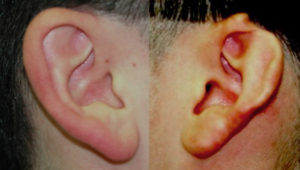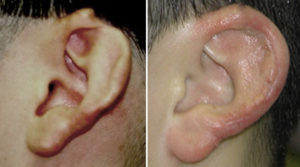Background: As a projecting structure from the side of the head with a funnel-like and flexible attachment, the ear can withstand a wide variety of deforming forces. Its very flexibility protects it from injury when exposed to shearing forces. Like a palm tree in high winds its ability to bend is a protective mechanism.
But when the ear is grabbed by a sharp or compressive force, it is going to tear and suffer a partial loss…or even a total detachment from its base. This occurs in the ear from bite injuries, whether it be from an animal or a human. Loss of portions of the ear from such injuries are well chronicled.
Reconstruction of missing portions of the ear almost always requires a composite technique as both skin and cartilage are needed. The skin is needed to provide an epithelized cover and cartilage is needed to restore framework support for any of its convex or tiered levels. Such methods of ear reconstruction have a long history and date back well into the history of plastic surgery.




Highlights:
1) Loss of ear segments usually requires both cartilage and skin replacements.
2) The skin for helical rim reconstruction can be created from a two-stage postauricular skin flap.
3) Helical rim framework reconstruction can be done with a rolled alloplastic material like ePTFE.
Dr. Barry Eppley
Indianapolis, Indiana


